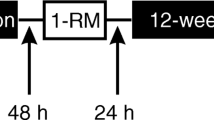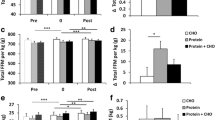Abstract
This study examined the effect of bovine colostrum (BC) supplementation on the tissue composition of resistance trained (T) and untrained (UT) limbs. Using a double-blind design, subjects were randomly allocated to 60 g day−1 of BC (n=17) or whey protein (WP) (n=17) during 8 weeks of resistance training of the elbow flexors (EF) of their non-dominant arm (T). Axial magnetic resonance images of both upper arms, maximal voluntary isometric torque (MVC) of EF, and the one repetition maximum (1RM) for bicep curls were measured pre- and post-supplementation. There were no differences in macronutrient intakes (P>0.28) or the volume of training completed by T (P=0.98) between the two groups. T of BC experienced a significantly greater increase in circumference [BC 2.3 (3.0)%, WP 0.0 (4.2)%; P=0.05] and cross-sectional area (CSA) [BC 4.2 (6.0)%, WP −0.2 (8.3)%; P=0.05] compared with WP, due principally to a greater increase in skin and subcutaneous fat (SSF) CSA [BC 5.5 (10.9)%, WP −2.7 (14.1)%; P=0.03]. No tissue compartment changed significantly in UT of either group (P>0.05). MVC and 1RM increased for T and UT in both groups (P<0.05), but the increases were not different between groups (P>0.32). Since the SSF compartment increased in T but not UT, and fat turnover in adipocytes is under hormonal control and would not be localised to one arm, we suggest that the increase in SSF CSA in T of BC may have been due to an increase in skin CSA, rather than fat.

Similar content being viewed by others
References
Antonio J, Sanders MS, Van Gammeren D (2001) The effects of bovine colostrum supplementation on body composition and exercise performance in active men and women. Nutrition 17:243–247
Belford DA, Rogers ML, Francis GL, Payne C, Ballard FJ, Goddard C (1997) Platelet-derived growth factor, insulin-like growth factors, fibroblast growth factors and transforming growth factor beta do not account for the cell growth activity present in bovine milk. J Endocrinol 154:45–55
Berseth CL (1987) Enhancement of intestinal growth in neonatal rats by epidermal growth factor in milk. Am J Physiol 253:G662–G665
Brinkworth GD, Buckley JD, Bourdon PC, Gulbin JP, David AZ (2002) Oral bovine colostrum supplementation enhances buffer capacity but not rowing performance in elite female rowers. Int J Sport Nutr Exerc Metab 12:349–363
Buckley JD, Abbott MJ, Brinkworth GD, Whyte PBD (2002) Bovine colostrum supplementation during endurance running training improves recovery, but not performance. J Sci Med Sport 5:65–79
Buckley J, Brinkworth G, Abbott M (2003) Effect of bovine colostrum on anaerobic exercise performance and plasma insulin-like growth factor I. J Sports Sci 21:577–588
Burrin DG, Shulman RJ, Reeds PJ, Davis TA, Gravitt KR (1992) Porcine colostrum and milk stimulate visceral organ and skeletal muscle protein synthesis in neonatal piglets. J Nutr 122:1205–1213
Burrin DG, Wester TJ, Davis TA, Amick S, Heath JP (1996) Orally administered IGF-1 increases intestinal mucosal growth in formula-fed neonatal pigs. Am J Physiol 270:R1085–R1091
Burrin DG, Davis TA, Ebner S, Schoknecht PA, Fiorotto ML, Reeds PJ (1997) Colostrum enhances the nutritional stimulation of vital organ protein synthesis in neonatal pigs. J Nutr 127:1284–1289
Campbell PG, Baumrucker CR (1989) Insulin like growth factor 1 and its association with binding proteins in bovine milk. J Endocrinol 120:21–29
Coombes J, Conacher M, Austen S, Marshall P (2002) Dose effects of oral bovine colostrum supplementation on physical work capacity in cyclists. Med Sci Sports Exerc 34:1184–1188
Donovan SM, Odle J (1994) Growth factors in milk as mediators of infant development. Annu Rev Nutr 14:147–167
Fleckenstein J, Haller R, Lewis S, Archer B, Barker B, Payne J, Parkey R, Peshock R (1991) Absence of exercise-induced MRI enhancement of skeletal muscle in McArdle's disease. J Appl Physiol 71:961–969
Garfinkel S, Cafarelli E (1992) Relative changes in maximal force, EMG, and muscle cross-sectional area after isometric training. Med Sci Sports Exerc 24:1220–1227
Hofman Z, Smeets R, Verlaan G, Lugt R v d, Verstappen PA (2002) The effect of bovine colostrum supplementation on exercise performance in elite field hockey players. Int J Sport Nutr Exerc Metab 12:461–479
Janssen I, Heymsfield SB, Wang Z, Ross R (2000) Skeletal muscle mass and distribution in 468 men and women aged 18-88 years. J Appl Physiol 89:81–88
Jones JI, Clemmons DR (1995) Insulin-like growth factors and their binding proteins: biological actions. Endocrinol Rev 16:3–34
Kuipers H, Breda E van, Verlaan G, Smeets R (2002) Effects of oral bovine colostrum supplementation on serum insulin-like growth factor-I levels. Nutrition 18:566–567
Mero A, Miikkulainen H, Riski J, Pakkanen R, Aalto J, Takala T (1997) Effects of bovine colostrum supplementation on serum IGF-1, IgG, hormone and saliva IgA during training. J Appl Physiol 83:1144–1151
Mero A, Kähkönen J, Nykänen T, Parviainen T, Jokinen I, Takala T, Nikula T, Rasi S, Leppäluoto J (2002) IGF-1, IgA, and IgG responses to bovine colostrum supplementation during training. J Appl Physiol 93:732–739
Pakkanen R, Aalto J (1997) Growth factors and antimicrobial factors of bovine colostrum. Int Dairy J 7:285–297
Ranallo RF, Rhodes EC (1998) Lipid metabolism during exercise. Sports Med 26:29–42
Roman WJ, Fleckenstein J, Stray-Gundersen J, Alway SE, Peshock R, Gonyea WJ (1993) Adaptations in the elbow flexors of elderly males after heavy-resistance training. J Appl Physiol 74:750–754
Sale DG (1988) Neural adaptation to resistance training. Med Sci Sports Exerc 20:S135–S145
Sanders JE, Goldstein BS, Leotta DF (1995) Skin response to mechanical stress: adaptation rather than breakdown--a review of the literature. J Rehabil Res Dev 32:214–226
Weaver LT, Walker WA (1989) Uptake of macromolecules in the neonate. In: Lebenthal E (ed) Human gastrointestinal development. Raven Press, New York, pp 731–748
Westrom BR, Svendsen J, Ohlsson BG, Tagesson C, Karlsson BW (1984) Intestinal transmission of macromolecules (BSA and FITC-labelled dextran) in the neonatal pig. Biol Neonate 46:20–26
Wraight CJ, Werther GA (1995) Insulin-like growth factor-1 and epidermal growth factor regulate insulin-like growth factor binding protein-3 (IGFBP-3) in the human keratinocyte cell line HaCaT. J Invest Dermatol 105:602–607
Acknowledgements
This study was supported by funding from Numico Research Australia Pty Ltd, Adelaide, Australia.
Author information
Authors and Affiliations
Corresponding author
Rights and permissions
About this article
Cite this article
Brinkworth, G.D., Buckley, J.D., Slavotinek, J.P. et al. Effect of bovine colostrum supplementation on the composition of resistance trained and untrained limbs in healthy young men. Eur J Appl Physiol 91, 53–60 (2004). https://doi.org/10.1007/s00421-003-0944-x
Accepted:
Published:
Issue Date:
DOI: https://doi.org/10.1007/s00421-003-0944-x




